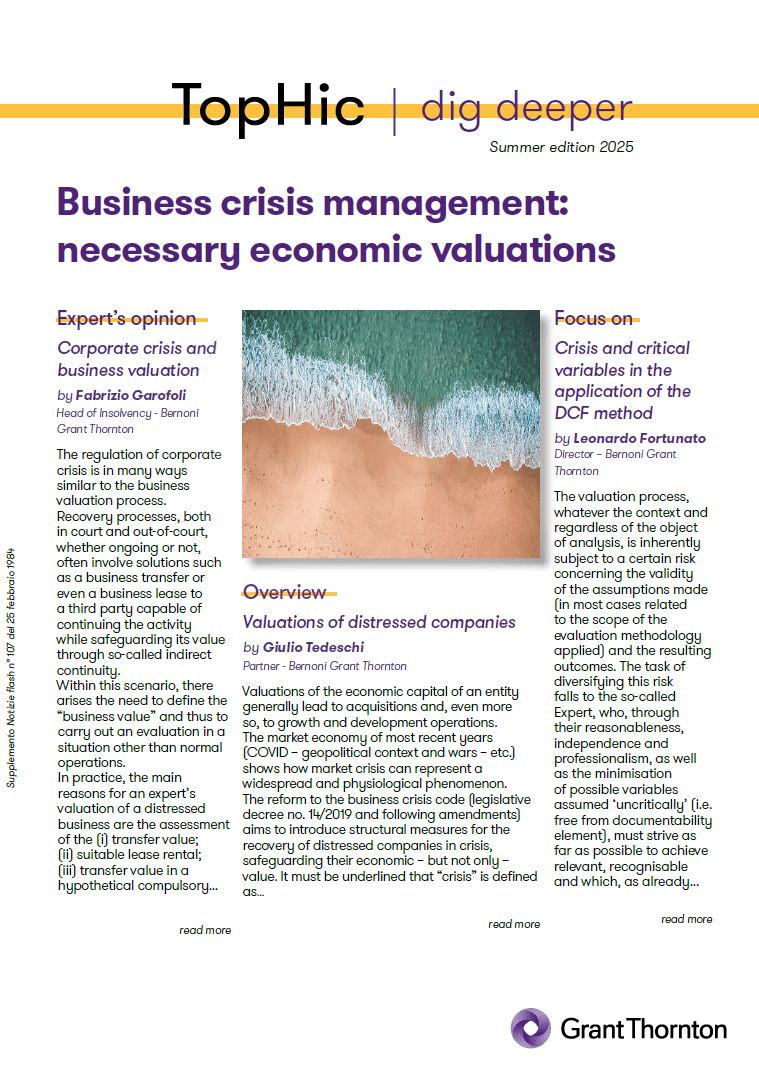
The regulation of corporate crisis is in many ways similar to the business valuation process.
Recovery processes, both in court and out-of-court, whether ongoing or not, often involve solutions such as a business transfer or even a business lease to a third party capable of continuing the activity while safeguarding its value through so-called indirect continuity.
Within this scenario, there arises the need to define the “business value” and thus to carry out an evaluation in a situation other than normal operations.
In practice, the main reasons for an expert's valuation of a distressed business are the assessment of the (i) transfer value; (ii) suitable lease rental; (iii) transfer value in a hypothetical compulsory liquidation scenario (be it through the transfer of the corporate equity or of the single assets); (iv) value reserved to shareholders upon conclusion of the recovery process; (v) value for possible extraordinary operations.
In similar circumstances, the relevance of an expert valuation is twofold: on the one hand it provides an estimate of the value generated by the positive outcome of the business turnaround process undertaken by the entrepreneur; on the other hand, it provides significant information for credit purposes, in order to favour an informed assessment of the economic and financial convenience of the debtor’s proposal.
The expert must carry out his evaluation independently, adopt a suitable professional scepticism, analyse the assumptions underpinning the Plan, the analysis performed by the attestor or subject in charge of the IBR and, should he believe there are further elements not considered in the Plan, make the appropriate adjustments.
By way of example, the evaluation of a distressed company must take into account endogenous variables, such as the potential loss of key resources, the evolution of the relationship with key suppliers, the contractual conditions proposed to clients, as well exogenous variables such as the dynamics of the reference industry and the market trend, which could influence the sustainability of the turnaround process.
The valuation
According to the Italian valuation principles, experts are required to indicate in their report:
- the aim
- the object
- the unit
- the value configuration
- the date
It is our opinion that, once clarified the prerequisites above, it is essential that the expert, in presenting his logical argumentative process, carefully reflects on the question of whether the valuation of a distressed company should be carried out based on its historical trend, on its current situation, or on the perspective industrial plan that includes the recovery plan.
The valuator is required to jointly consider and analyse all three phases, acknowledging that the latter - i.e. the perspective Plan - represents a potential scenario in which data are mainly the result of estimates. The historical trend, in most cases, cannot be considered as the sole reference parameter, since the results attained could reflect a significantly different corporate structure than the current one and the one after the recovery (these are, in any case, key data on which to focus attention). Therefore, when analysing results, it is crucial to identify the phase of the company’s lifecycle when the valuation is carried out, as well as the variables which allow it to attain the performance recorded.
In short, it is key to understand whether the valuation should be set up basing on an “as is” or “to be” approach.
In the first case, the valuation does not keep into account the assumptions underlying the recovery plan, but rather provides a snapshot of the company’s situation, operating adjustments in order to specifically identify the scope of the potential disposal.
In the second case, instead, the valuator must consider the value in relation to the recovery plan and focus his attention on the underlying assumptions. It is crucial to quantify the risk that the hypothetical recovery plan may deviate from that expected trend over the financial years (execution risk), analyse how the variations could influence the plan and whether the company has foreseen any corrective measures capable of ensuring compliance with the original strategy (stress test scenarios, sensitivity analyses and the allocation of generic risk provisions in the recovery plan are therefore essential). Moreover, assuming that the plan may lead to an increased degree of uncertainty over time (plan timeframe), it is advisable to define an incremental discount rate different for each future financial year.
As for the identification and quantification of risks - an activity which directly impacts on the determination of the discount rate to be adopted (WACC, Ke) - the expert must pay specific attention to the risk of double counting that the recovery plans devised under a crisis include prudential assumptions ant therefor the available data already reflect prudential estimates.
